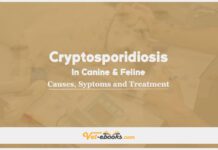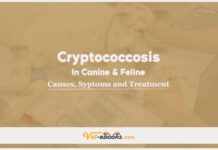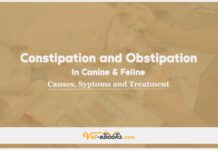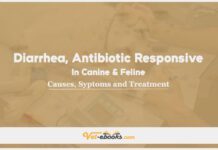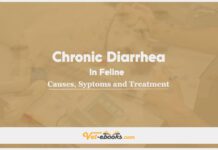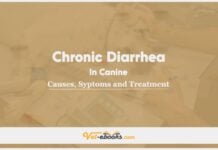Colitis and Proctitis In Canine and Feline: Causes, Symptoms and Treatment

Contents
hide
Overview
- Colitis is the inflammation of the colon.
- This condition manifests as acute, self-limiting, or chronic.
- Colitis does not imply causality, and it is important to identify the underlying etiology, especially in cases that are chronic.
- Proctitis is the inflammation of the rectum.
Causes of Colitis and Proctitis In Canine and Feline
Causes
- Food-induced enteropathy, dietary indiscretion, and food intolerance.
- Medications, such as antibiotics and NSAIDs.
- Trichuris vulpis, Entamoeba histolytica, Balantidium coli, Tritrichomonas blagburni, Clostridium perfringens, and Clostridium difficile.
- Campylobacter jejuni and Campylobacter coli.
- Yersinia enterocolitica, Prototheca, Histoplasma capsulatum, and pythiosis/phycomycosis.
- Foreign bodies or abrasive materials.
- The presence of inflammation can be attributed to the occurrence of pancreatitis, specifically transverse colitis.
- Inflammatory bowel disease encompasses many forms of colitis, including lymphoplasmacytic, eosinophilic, and granulomatous colitis, (characterized by immune-mediated inflammation in the colon).
Risk factors
- Genetic predispositions for specific subgroups of colitis.
- Environmental factors predispose to parasite infections such as whipworms and Tritrichomonas, and viral diseases like histoplasmosis and pythiosis.
- Patients with impaired immune systems have an increased susceptibility to parasitic and infectious causes.
- Elderly patients exhibit a higher susceptibility to the development of neoplastic diseases.
Pathogenesis of Colitis and Proctitis In Canine and Feline
- The buildup of inflammatory cytokines, disruption of tight connections between epithelial cells, stimulation of colonic secretion, stimulation of goblet cell secretion of mucus, and disruption of motility are consequences of colonic inflammation.
- These mechanisms hinder the colon’s capacity to effectively absorb water and electrolytes, and retain fecal matter, resulting in recurrent diarrhea accompanied by mucus and/or blood.
Symptoms (History & Physical Examination) of Colitis and Proctitis In Canine and Feline
History
- Fecal consistency exhibits variability, from semi-formed to liquid.
- Increase in the frequency of defecation, from 6 to 15 times per day, with reduced fecal volume.
- Tenesmus.
- Elevation in the presence of mucus in the fecal matter.
- Cats exhibit hematochezia.
- Infrequent dyschezia.
- Heightened sense of urgency to evacuate the bowels.
- Vomiting in roughly 30% of patients with colitis.
Physical Examination
- Usually unremarkable
- Thickened and irregular mucosa in the colorectal region.
- Canines affected by gastrointestinal cancer may exhibit systemic indications such as weight loss and loss of appetite.
Diagnosis of Colitis and Proctitis In Canine and Feline
1- From History and Physical Examination
2- Diagnostic Procedures
CBC/BIOCHEMISTRY/URINALYSIS
- The outcomes may not exhibit any notable findings.
- In cases of intense inflammation, there is an increase in neutrophils with a shift towards immature forms.
- Parasite causes lead to an elevation in eosinophil levels.
- Anemia caused by chronic inflammation, while iron deficiency anemia is induced by intestinal blood loss.
- Patients with viral or neoplastic diseases exhibit hyperglobulinemia and hypercalcemia.
- Urinalysis is generally undetectable; nonetheless, it should be examined to exclude the possibility of lower urinary tract disease.
Other Laboratory Tests
- It is important to eliminate parasitic causes as potential etiologies.
- The diagnostic procedures vary depending on the characteristics of the patient.
- These diagnostic measures encompass fecal centrifugation flotation, direct fecal smear, fecal culture and sensitivity, and fecal bacterial toxin immunoassays for C. perfringens enterotoxin and C. difficile toxins A and B.
- PCR for bacteria and other potential causes.
- ELISA for intestinal parasites and Pythium, and the submission of fecal samples for Tritrichomonas testing using the InPouch™ method.
- Rectal scraping for cytological examination or urine antigen testing for the detection of Histoplasma.
- When there is suspicion of hypoadrenocorticism, baseline cortisol and ACTH stimulation tests are made.
Imaging:
- Abdominal radiographs exhibit no significant findings, although they may reveal an underlying cause such as ileus or neoplasia.
- Abdominal ultrasonography yields normal findings, but it also detects various abnormalities such as masses, widespread thickening or altered structure of the colon, and enlarged lymph nodes in the vicinity.
3- Differential Diagnosis
- Neoplasia including lymphoma, adenocarcinoma, and sarcomas.
- Irritable bowel syndrome (IBS).
- Colorectal polyps.
- Cecal inversion and ileocecal intussusception.
Treatment of Colitis and Proctitis In Canine and Feline
General
- The primary goals of treatment are to address the root cause of the disease and eliminate the necessity for long-term care.
- Where a complete remedy is unattainable, the primary objective is to achieve sustained management of observable symptoms while minimizing any adverse effects that arise from medications.
- If a comprehensive diagnostic assessment is unattainable, it has become customary to initially choose empirical deworming (such as fenbendazole), followed by a food trial, an antibiotic trial (using metronidazole or tylosin), and contemplate immune suppressant medication.
Medications:
Parasitic/Bacterial Etiologies
- Fenbendazole for Trichuris (50 mg/kg orally once daily for five consecutive days) should be repeated after a three-month interval.
- Ronidazole for Tritrichomonas foetus (30 mg/kg every 24 hours for 14 days).
- Metronidazole for Clostridium perfringens (10 mg/kg orally every 12 hours for 5 days) or tylosin (5–10 mg/kg orally every 24 hours for 5 days).
- Metronidazole for Clostridium difficile (10 mg/kg orally every 12 hours for 5 days).
- Erythromycin for Campylobacter species (10–15 mg/kg orally every 8 hours) or azithromycin (5–10 mg/kg orally once a day) for 7–10 days.
- Itraconazole for Histoplasma (10 mg/kg orally every 24 hours for dogs and 5 mg/kg orally every 12 hours for cats).
- Amphotericin B (0.25–0.5 mg/kg intravenously every 48 hours, up to a cumulative dose of 4–8 mg/kg) in advanced instances.
- Itraconazole (10 mg/kg orally every 24 hours) and terbinafine (10 mg/kg orally every 24 hours) for pythiosis are the preferred medications after surgical removal of diseased sections of the colon.
- Fluoroquinolones are the preferred antibiotics for urinary tract infections.
- In the past, enrofloxacin (10 mg/kg orally every 24 hours for 4-6 weeks) was a suggested treatment, but new literature suggests that there is a growing concern regarding the development of resistance.
- Therapy should be predicated on the outcomes of tissue culture and sensitivity.
Inflammatory/Immune‐Mediated Colitis
- Sulfasalazine and other 5-aminosalicylic acid (5-ASA) medicines were deemed a viable option after evaluating the patient’s response to dietary intervention.
- This approach for instances where there are modest indications of illness prior to contemplating more assertive treatment, (25–40 mg/kg orally every 8 hours for 3-6 weeks for dogs) and (20 mg/kg orally every 12 hours for 3 weeks for cats).
- Metronidazole (10 mg/kg orally every 12 hours) has antibacterial and immune-modulating capabilities.
- Corticosteroids exhibit the strongest evidence for effectiveness in immune-mediated diseases, such as prednisone for canines and prednisolone for felines (1-2 mg/kg every 12 hours).
- It is important to adhere to a maximum daily dosage of 50 mg of prednisone, irrespective of the animal’s size.
- Azathioprine, (1-2 mg/kg orally per day, once per 24 hours, for 10–14 days) exclusive to canines requires several weeks before its therapeutic effects become evident, then gradually reduced to (1-2 mg/kg every 48 hours over 4-6 weeks).
- Chlorambucil is a potent immunomodulator (0.1–0.2 mg/kg once every 24 hours for 8–12 weeks for dogs) and (2 mg per cat once every 3–4 days for 2-3 months for cats). It is prescribed in combination with prednisone or prednisolone.
- Cyclosporine is a strong immunomodulator (5 mg/kg, orally every 12 to 24 hours for 6 weeks).
Some Notes:
- Sulfasalazine has been linked to keratoconjunctivitis sicca (KCS), so assess tear production (Schirmer tear test) at the beginning and afterward every two weeks for the entire duration of medication.
- Patients using azathioprine should undergo regular monitoring for bone marrow suppression via CBC every 2–3 weeks. If the WBC count drops below 3000 cells/μL, discontinue treatment or switch to an alternate-day regimen.
Tip
Do You Want To Increase Your Veterinary Knowledge and Practical Skills?
You Can Now Browse and Download +3000 Books For Veterinary Professionals & Students Online.
Download Veterinary Books

